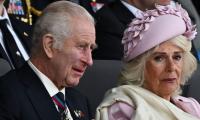Donald Trump presents himself as a ‘man’s man’, a symbol of the sexual prowess that only wealth and influence grants; he’s the all-American super-stud. He is the first presidential candidate since John Kennedy to actively court – flirt with – the American public and try to seduce them for their vote. Where Bill Clinton played the cute guy next door, Kennedy was a notorious womaniser and his numerous affairs were well known to those who wanted to know. Like JFK, Trump plays the stud card for all its worth.
JFK suggested a new spirit of possibility; Trump suggests Kennedy’s end-point, the closing of possibility. Trump campaign slogan is ‘Make America Great Again’ and it is the unspoken phantasy of the other Republican presidential aspirants as well – a wish to return America to its former glory. But which past?; the America of slavery, the Gilded Age, Prohibition or the Red Scare?
The post-WWII era was the zenith of American ‘greatness’; it was the era of the ‘American Dream’, when military masculinity was triumphant. It saw a real general, Dwight Eisenhower, elected president, the first general since Ulysses Grant of the 1870s. John Kennedy, a WWII veteran and playboy grandee, followed; he symbolised the US in its domestic and international ascendency.
The American Dream is over and Trump – along with anybody listening to Sen Bernie Sanders (I-VT) – knows it. The challenge for Republican politicians today, the great con, is to convince American voters that the political saviour can change history. Sadly, the US can be a mean, crazy country and Trump could become the next president.
Trump’s masculine prowess was honed in ruthless business deals and perfect in his popular TV series, The Apprentice, that recalled the savagery of Roman gladiators; it ran for 14 seasons and drew over 100 million viewers that gave him more media exposure – and name recognition – than the other Republican candidates. His supports believe he says what he wants to say, with no PR shill telling him what the polls show. Like Sanders, Trump is his own man.
But Trump has a peculiar relation to women. He’s been married three times to glamorous – and very white – ‘damsels’.
Findings from a series of national polls point to a deeper problem in which Trump’s rants – particularly against women – might come back to upset his presidential bid. A Quinnipiac University poll found that that among women, Trump had an unfavourable rating of 68 percent and a favourability rating of only 25 percent. A CNN survey had similar findings; 64 percent of women said they did not like him, while men were basically split (44 percent favourable, 47 percent unfavourable).
This is a frightening picture: Trump as commander-in-chief, leader of the world’s most powerful military force. Still more frightening, one can well image Trump, once anointed president, restaging George Bush’s 2003; ‘Mission Accomplished’ speech aboard the aircraft carrier USS Abraham Lincoln to announce a new campaign against an enemy whether real or (like Bush’s) falsified.
If the 2016 presidential election comes down to a choice between Trump and Hillary Clinton, the US will face not simply a choice between political parties and people of different genders, but two very different ideologies. And these differences are split not simply in terms of likely domestic programmes but international policies.
Ironically, Trump is very much in step with his fellow ‘conservative’ Republican candidates in terms of domestic policies (eg, furthering the interests of the 1 percent), thus different from the two Democratic contestants. However, he seems more ‘moderate’ with regard to an international interventionist strategy than either his Republican competitors or Clinton, a militaristic hawk.
Masculinity is in crisis. Many Americans – and especially aging white people – feel threatened; their world is coming to an end and they know it but can’t do anything.
The great post-WWII era of prosperity is over and postmodern inequality is intensifying. The economic and political crisis confronting a growing number of white Americans, especially men, is driven less by people of colour (who are poorer and suffer greater hardships), but by the policies of the – mostly white – “1 percent,” those with real power.
In November 2015, two Princeton economists, Anne Case and Angus Deaton (a Nobel-Prize winner), published a rigorously-argued academic paper, “Rising morbidity and mortality in midlife among white non-Hispanic Americans in the 21st century,” in the prestigious Proceedings of the National Academy of Sciences. It generated considerable – if short lived – media and public attention. Sadly, but not unexpected, the story found little resonance among the Republican presidential contestants.
The economists’ findings were scary: “Over the 15-y[ear] period, midlife all-cause mortality fell by more than 200 per 100,000 for black non-Hispanics, and by more than 60 per 100,000 for Hispanics. By contrast, white non-Hispanic mortality rose by 34 per 100,000.” In one of their few non-technical digressions, the scholars acknowledge: “After the productivity slowdown in the early 1970s, and with widening income inequality, many of the baby-boom generation are the first to find, in midlife, that they will not be better off than were their parents. Growth in real median earnings has been slow for this group, especially those with only a high school education.”
Trump’s bravado recalls the once-embraced false masculinity typified by “the Duke,” John Wayne. His ‘T’ reverberates both for his name, ‘Trump’ but also testosterone, the unstated masculinity force driving the Republican primaries. He is the symbol of American masculinity’s last stand against profound and irreversible crisis of traditional patriarchy.
Sadly, among the displaced people of postmodern capitalism is the Trump-wanna-bes, those who are terrified by lives not lived. Trump is the 21st century Alger Hill, the phantasy ‘everyman’: if he could make it, so could you! Sadly, the overwhelmingly white voter he appeals to is overweight (63 percent) and, in 2013, had one of the highest suicide rates in the country (14.2 per 100,000); the highest rate of suicide is among US military veterans, many of these are white men
This article has been excerpted from: ‘Donald Trump and the crisis of
masculinity’.
Courtesy: Counterpunch.org
After November 30, it will be impossible for ordinary internet users to access all banned websites, including X
Muslims participated alongside their Hindu fellow villagers and other residents of area
For last eight years, HEC's budget has been virtually stagnant in absolute terms
Home to 14 million people, Lahore has always been celebrated as Pakistan’s historical, culinary, and cultural hub
Partnership between Pakistan and China in media and culture reflects shared commitment to strengthening bilateral...
This article focuses on single error committed by our respected judiciary which haunts me more than I would care to...







